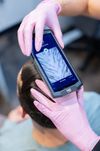community Boys I am just a gonner. What on earth is my scalp even going through. Looks like world war 3. Pyril 3 months. Topical melitonin/progesterone/fin, dut, fin, oral min, laser trash, anus stimulation. Nothing. Donor area is decimated 😂.
Treating Seborrheic Dermatitis, a fungal scalp condition which can cause hair loss. Treatments discussed include antifungal shampoos, cold showers, exfoliating the scalp, taking Vitamin D, and stimulating the prostate through the anus.
